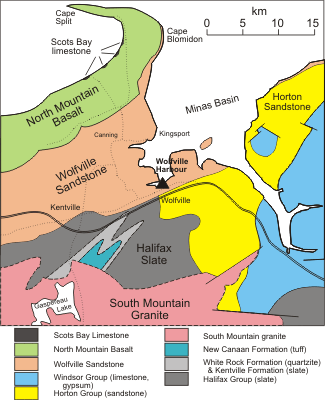Wickwire Dyke, east side Wolfville Harbour
By J.A. Colwell & S.A. Ferguson
 ROUTE - From Main Street at the junction with
Victoria
Avenue follow the laneway north for 75 m (250 feet) to the railway.
Continue
along the path on top of the dyke or the roadway beside the dyke. Beyond
the
sewage lagoons the roadway leaves the dyke and continues eastward to
Grand Pre.
It is about 3.5 km to Grand Pre.
ROUTE - From Main Street at the junction with
Victoria
Avenue follow the laneway north for 75 m (250 feet) to the railway.
Continue
along the path on top of the dyke or the roadway beside the dyke. Beyond
the
sewage lagoons the roadway leaves the dyke and continues eastward to
Grand Pre.
It is about 3.5 km to Grand Pre.
DESCRIPTION - The dyke is an earth fill erected to keep out the sea and is maintained by the Nova Scotia Department of Agriculture. The material for the dyke is excavated from the river side by a large earth-moving machine. The most commonly used rock for protection of the dyke is White Rock quartzite, along with a smaller amount of North Mountain basalt. Because of continuing sedimentation the land level on the river side of the dyke is usually higher than on the landward side. On the Cornwallis River side there is a salt marsh which at high tide is partly or completely flooded and where salt tolerant plants flourish. On the upper salt marsh, which is only flooded by spring tides a few times a year, marsh hay predominates. Cordgrass, which is taller with wider leaves, predominates in the lower salt marsh. In the fall, the dead leaves of the cordgrass are washed into the estuary, but the marsh hay forms a dense mat of peaty material and a more fertile soil.
Water drains from the dykeland by means of "aboiteaux" which are concrete culverts with a hinged door . The door opens at low tide to allow the fresh water to drain out and closes at high tide to keep out the salt water.
When a marshland is first drained it takes at least two years for the natural precipitation to leach out the salt so that the soil is usable for agriculture. The soils of the dykeland (polder) are an organically-rich sandy to silty loam. Poor drainage and susceptibility to frost are limiting factors for agriculture.
The Wolfville-Grand Pre sewage lagoons consist of ponds where solids are broken down by an aeration process. The bacterial count is reduced 90 percent by chlorinating the effluent.
Reference: Anon, 1987. Maritime Dykelands. Nova Scotia Department of Agriculture and Marketing. Available from Nova Scotia Government Bookstore, 1700 Granville Street, Halifax, Nova Scotia B3J 2R7
Prepared for the Geological Association of Canada and Mineralogical Association of Canada Joint Annual Meeting in Wolfville, Nova Scotia. May 25-27, 1992. Meeting Hosted by the Atlantic Geoscience Society.
